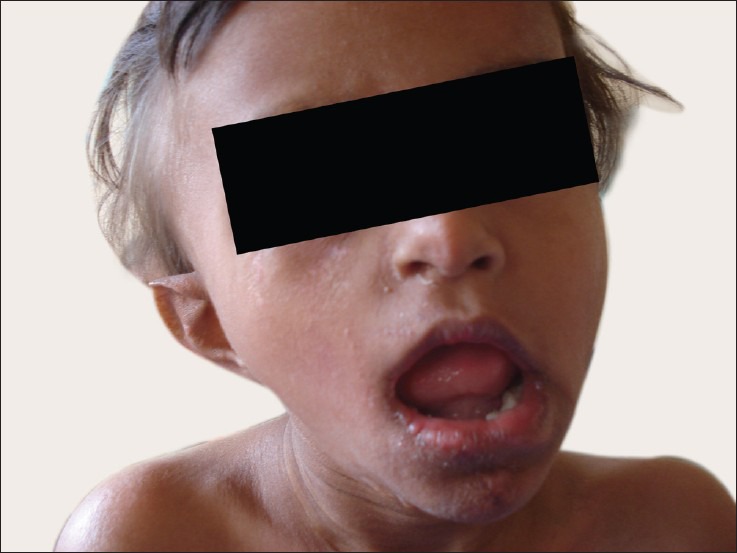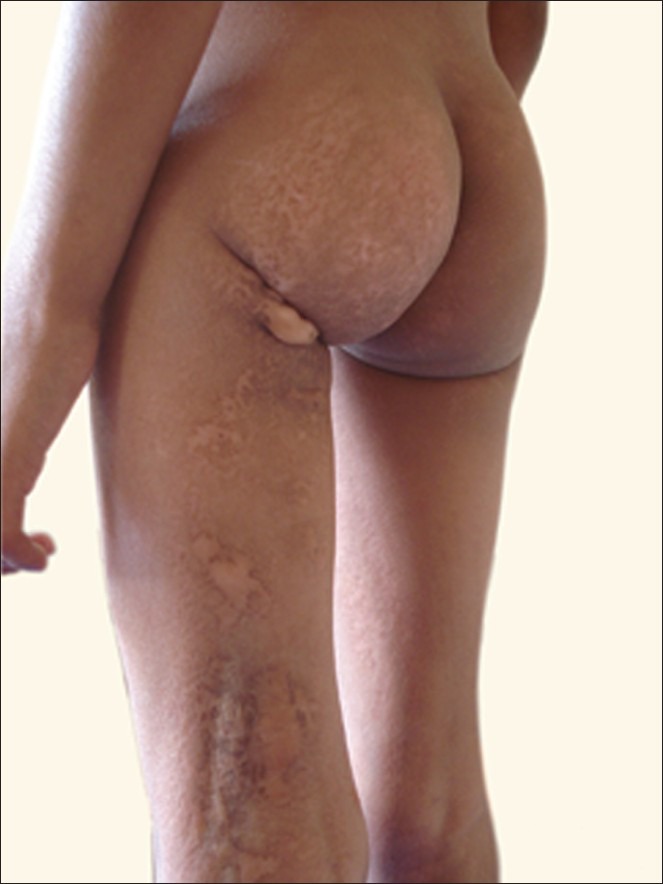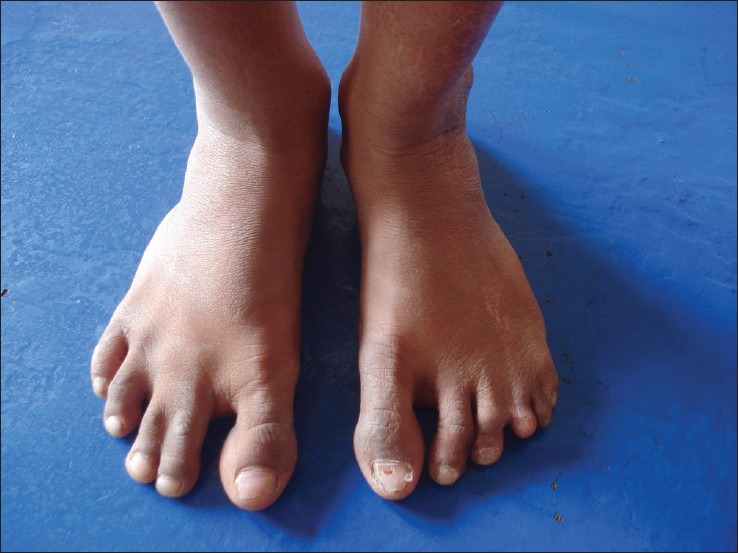Abstract
Goltz syndrome is a rare multisystem disorder with cutaneous, ocular, dental and skeletal abnormalities. Other mesoectodermal abnormalities are also present. Its hallmark is thinning of the dermis resulting subcutaneous fat herniation. The present case is a 5 year old girl having linear skin atrophy with fat herniation, skeletal abnormalities in the form of polysyndactyly, facial asymmetry, squint with coloboma iris, deformed pinna, abnormal dentition, umbilical hernia along with osteopathia striata of long bones which is consistent with Goltz syndrome. We are presenting this case due to its rarity.
Keywords: Focal dermal hypoplasia, fat herniation, Goltz syndrome
INTRODUCTION
Goltz syndrome is a rare syndrome characterized by dermal thinning which leads to fat herniation with cutaneous and systemic abnormalities. It is inherited as an X linked dominant gene, which is lethal in males. It was first identified by Goltz et al. in 1962 with a report of three affected girls.[1] Even though 200 cases have been reported worldwide, their paucity in Indian literature prompted us to report this case.[2,3,4,5]
CASE REPORT
A five-year-old female born out of non-consanguineous marriage presented to the outpatient department for right-sided facial deformity with multiple generalized skin lesions since birth. She was delivered normally with no untoward perinatal event. She was second in birth order and her two sisters were normal. She did not have developmental delay and was going to school. She was weighing 10.2 kilograms and her height was 96 centimeters as against expected weight and height of 18 kilograms and 105 centimeters, respectively. She had right-sided facial hypoplasia [Figure 1] with unilateral notching of right ala nasi, deformed pinna with low set ears. She had concomitant squint with coloboma iris in right eye along with patchy alopecia. Dental check up showed maloccluded, hypoplastic irregular dentition. Cutaneous examination revealed multiple linear atrophied hypo- and hyperpigmented macules along the lines of Blaschko [Figure 2]. She had limb deformities in the form of syndactyly in both feet, polydactyly in left foot [Figure 3] and clinodactyly of right fifth finger. She also had multiple papillomas on lips, fat herniation over the lower limbs and umbilical hernia. Onychodystrophy was also present. Her right-sided chest was flattened and lordosis was observed on standing.
Figure 1.

Facial features in Goltz syndrome
Figure 2.

Macular atrophy, pigmentary changes of skin and fat herniation
Figure 3.

Polysyndactyly of left foot with syndactyly of right foot with nail dystrophy
Systemic examination was normal. Ultrasound of abdomen, echocardiography was normal. However, the patient did not consent for a skin biopsy. Radiographs of the long bones showed the features of osteopathia striata in the form of symmetrical striations in metaphyses. Goltz syndrome was considered and the patient was counseled accordingly. Patient was referred first to plastic surgeon for polysyndactyly and to dental surgeon for malocclusion teeth and counseled to visit next to orthopedician & ophthalmologist.
DISCUSSION
Goltz syndrome is a X-linked inherited disease with a probable locus at Xp11.23. The gene in this disorder has been identified as PORCN. It has a multitude of clinical features having developmental skin defects with ocular, dental and skeletal anomalies.
Skin involvement is considered as essential for the diagnosis of Goltz syndrome, and most of the cutaneous manifestations were seen in this case. This patient however did not have papillomas over the perineum, buccal mucosa or ears, or telangiectasias. Though she had only maloccluded, hypoplastic irregular dentition, many other dental abnormalities have been reported such as absence of teeth, enamel defects, and slow eruption of defectively formed teeth.
Skeletal defects are second most common extracutaneous abnormalities, seen in 80% of the patients[6] that include asymmetrical involvement of hands and feet with syndactyly, polydactyly or clinodactyly. This patient had syndactyly of both the feet and polydactyly of left foot. Vertebral anomalies may be seen as scoliosis, kyphosis, vertebral body fusions and spina bifida. Many patients have short stature, and one side of the face or body may be underdeveloped. In the present case, short stature, facial asymmetry with right-sided hypoplasia, unilateral notching of right ala nasi, deformed pinna and low set ears and lordosis were present along with characteristic osteopathia striata of long bones. Ocular anomalies include coloboma of iris, retina and globe; microphthalmia, anophthalmia, lacrimal duct anomalies as well as ocular muscles and corneal anomalies.[6] This patient had squint with coloboma of iris on ophthalmic examination.
Occasionally, some anomalies like joint hypermobility, mental retardation, hearing defects, microcephaly, horseshoe kidneys, umbilical, inguinal, epigastric or diaphragmatic hernias, malrotation of the gut, duodenal atresia, cleft lip/palate and congenital heart diseases like truncus arteriosus are seen in Goltz syndrome.[7,8] Because of pleomorphism, all features may not present in a single case. Our case had umbilical hernia with no mental retardation, cardiac, renal or hearing defects.
Diagnosis was clinical, as genetic study to pinpoint the exact nature of the defect could not be done due to lack of the facility. Though this condition is X-linked dominant and lethal in males, some males have been reported to survive till adulthood. This condition has to be differentiated from incontinentia pigmenti, epidermal naevi, aplasia cutis congenita and MIDAS syndrome (Microphthalmia, Dermal Aplasia and Sclerocornea) on the basis of clinical features.
Early recognition of Goltz syndrome may lead to more effective intervention with the treatment by an orthopedician, ophthalmologist, dentist, pediatrician and dermatologist. Cryotherapy and pulsed dye laser may be helpful to manage papillomas and telangiectasia. Frequent evaluation is required in order to prevent further damage. It is important to address not only the physical defects and functional problems but also the psychological issues that may accompany the syndrome. Prognosis in females is good and life expectancy may be normal. Genetic counseling is the mainstay as part of preventive measures.
Footnotes
Source of Support: Nil
Conflict of Interest: None declared
REFERENCES
- 1.Goltz RW, Peterson WC, Gorlin RJ, Ravits HG. Focal dermal hypoplasia. Arch Dermatol. 1962;86:708–17. doi: 10.1001/archderm.1962.01590120006002. [DOI] [PubMed] [Google Scholar]
- 2.Irvine AD, Mellerio JE. Genetics and genodermatoses. In: Burns T, Breathnach S, Cox N, Griffiths C, editors. Rook's Textbook of Dermatology. 8th ed. Oxford: Wiley-Blackwell; 2010. pp. 15.1–15.97. [Google Scholar]
- 3.Premalatha S, Kalyani NM, Janaki VR, Chandrasekaran A, Thambiah AS. Focal dermal hypoplasia syndrome: (a case report) Indian J Pediatr. 1981;48:781–3. doi: 10.1007/BF02758552. [DOI] [PubMed] [Google Scholar]
- 4.Sudha R, Veeraraghavan M, Frederick M, Mittal M, Adikrishnan S, Shobana S, et al. Goltz Syndrome (Focal Dermal Hypoplasia) Indian J Dermatol. 2005;50:104–6. [Google Scholar]
- 5.Riyaz N, Riyaz A, Chandran R, Rakesh SV. Focal dermal hypoplasia (Goltz syndrome) Indian J Dermatol Venereol Leprol. 2005;71:279–81. doi: 10.4103/0378-6323.16624. [DOI] [PubMed] [Google Scholar]
- 6.Hall EH, Terezhalmy GT. Focal dermal hypoplasia syndrome. Case report and literature review. J Am Acad Dermatol. 1983;9:443–51. doi: 10.1016/s0190-9622(83)70157-x. [DOI] [PubMed] [Google Scholar]
- 7.Patel JS, Maher ER, Charles AK. Focal dermal hypoplasia (Goltz syndrome) presenting as a severe fetal malformation syndrome. Clin Dysmorphol. 1997;6:267–72. doi: 10.1097/00019605-199707000-00012. [DOI] [PubMed] [Google Scholar]
- 8.Han XY, Wu SS, Conway DH, Pawel BR, Punnett HH, Martin RA, et al. Truncus arteriosus and other lethal internal anomalies in Goltz syndrome. Am J Med Genet. 2000;90:45–8. [PubMed] [Google Scholar]


